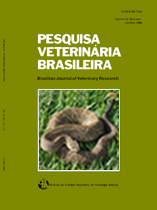 |
|
|
|
Year 2006 - Volume 26, Number 2
|

|
Intoxicação por Ramaria flavo-brunnescens (Clavariaceae) em bovinos
|
ABSTRACT.- Barros R.R., Irigoyen L.F., Kommers G.D., Rech R.R., Fighera R.A. & Barros C.S.L. 2006. [Poisoning by Ramaria flavo-brunnescens (Clavariaceae) in cattle.] Intoxicação por Ramaria flavo-brunnescens (Clavariaceae) em bovinos. Pesquisa Veterinária Brasileira 26(2):87-96. Departamento de Patologia, Universidade Federal de Santa Maria, 97105-900 Santa Maria, RS, Brazil. E-mail: claudioslbarros@uol.com.br
Two oubreaks of poisoning by the mushroom Ramaria flavo-brunnescens are reported in cattle from two farms located in the municipalities of Santa Maria and São Gabriel, state of Rio Grande do Sul, during April-May 2005. Out of a total of 180 yearling calves that had access to a pasture with eucalyptus woods, 19 were affected and 10 died. The clinical courses were 8-15 days and clinical signs included depression, weight loss, dehydration, drooling, loosening and loss of the long hairs of the tip of the tail, smoothening of the dorsal surface of the tongue with occasional ulceration, loosening of the corneal encasement of horns, hard and ball-shaped feces covered with a film of mucous, hypopion, hyphema and corneal opacity. Two calves had leucocytosis due to mild regenerative left shift. Nine calves were necropsied. Necropsy findings confirmed the clinical observation and additionaly included fibrinonecrotic esophagitis, mainly in the distal third of the esophageal mucosa. Histopathological changes in the skin of the tail included orthokeratotic hyperkeratosis; hair folicles with irregular contours, thickening of the tricolemmal keratin layer with occasional formation of keratin plugs, and degeneration and necrosis of the outer root sheath. At the laminar region of the hooves, there was hyperplasia of the top of epidermal laminae with irregular keratinization and retention of nuclei; several epidermal laminae were shortened and fused. There was hemorrhage, fibrin and neutrophilic infiltrate in the dermal laminae. In the mucosa of the tongue there was thinning of the covering epithelium, atrophy and loss of filiform papillae, multifocal areas of dyskeratosis, and spongiosis of the basal cell layer. In some parts the epithelium was lost and the surface consisted of granulation tissue and mixed inflammatory cell infiltrate. The esophageal mucosae of six calves had varying degree of epithelial necrosis and inflammation. The loss of the covering epithelium revealed an underneath area of granulation tissue with heavy inflammatory infiltrate composed predominantly of neutrophils and macrophages. In six calves there were focal symmetric bilateral areas of malacia observed at the level of obex in the medulla oblongata and affecting the white matter and parts of the dorsal nucleus of the vagus and of the hypoglossal nucleus. The epidemiology, clinical signs, pathology, and pathogenesis of poisoning by R. flavo-brunnescens in cattle are discussed. |
| |
|
|
| |
|
 |